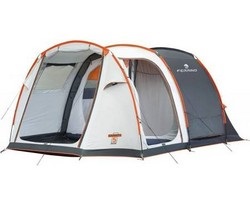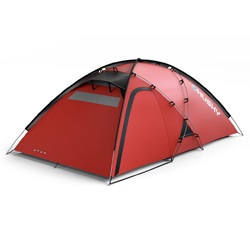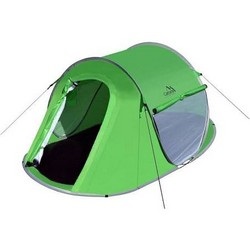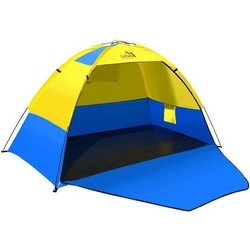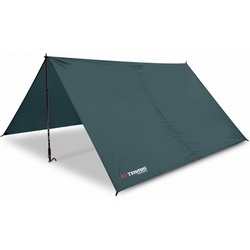

How To Choose a Tent
Tents are a great portable shelter that you can use for family and solo trips, in the garden and in more extreme weather conditions. But it is important to choose one carefully. With the right choice, a tent will serve you well for many years. So what should you focus on when choosing a tent?
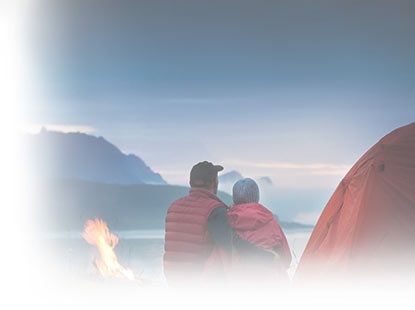
How to choose a tent? Some tips to help you choose
-
What you’re using the tent for will help you choose which one is right for you. Where and under what conditions will you camp? How often and with whom?
-
Find out what's more important to you. A low weight tent or comfort?
-
Are you planning to expand your family? Or, conversely, will the children soon start using the tent with their friends? Choose the size of the tent with the future in mind.
-
Keep in mind that you carry luggage and equipment with you. It often takes up as much space as one person.
-
Do you plan to move frequently? Focus on how the tent is folded and unfolded and the durability of the structure.
-
Do you require more comfort? Make sure that the interior is large enough and that there are enough entrances that you don’t have to crawl over your fellow campers or crouch down too much when entering the tent.
-
Make sure that the tent has not only a sufficiently durable floor and roof, but also functional ventilation.
-
Do you prefer a light or darker tent interior? The color of the tent also plays a role.
Parameters for tent selection
Purpose of using the tent
The very first and basic criterion for choosing a tent is the purpose of its use. Where and how often will you use the tent?
If you use the tent a few times a year, for example at festivals or for occasional overnight stays in nature, a standard tent will certainly suffice, the main advantage of which will be the low price. They will probably be tents suitable only for summer. They are usually not designed for carrying in a backpack, and therefore the main consideration when selecting one will be weight. Most often, these are dome-type tents with a laminate construction, which is heavier but cheaper. Such domes for recreational use will be smaller, usually for 2 people, and their advantage is they are self-supporting, which makes them easier to assemble. You can choose from the category of cheaper outdoor tents or self-folding tents.
If you often go on trips into nature, on foot or by bike, be sure to look at our selection of outdoor tents and ultralight tents. The emphasis here is on keeping them light, and therefore the duralumin construction is a great advantage. Both the floor and the walls should be made of lightweight material. Structurally, it can be a dome or a tunnel, but you should also consider elements that provide comfort. You can use outdoor tents for the seasons from spring to autumn.
If you are going to be using your tent in harsher conditions with inhospitable environments, higher altitudes etc, be sure to choose an expedition tent. They are a little more expensive, but the expedition tent will offer the most resistance to both bad weather conditions and to wear and tear. You will certainly appreciate the ease of use of the expedition tent and it is relatively light-weight.
A holiday with the family by the water or in the countryside is a great adventure. If you are planning such a holiday, a family tent is a clear choice and the main criterion should be space and comfort to enjoy your holiday properly. Be sure to focus not only on the number of rooms but also on the height of the tent being sufficient, the number and the location of exits, the ventilation system but also on equipment such as mosquito nets and storage space.
Bivvies offer fishermen protection in bad weather, but also a high level of comfort during longer stays. It is made specifically for fishing purposes.
If you go on a hike and do not want to bring a full tent with you, a tarpaulin, also called a tent, will suffice. This single-skin shelter is very light and compact and will protect you from the rain if necessary.
Tent shape
There are three basic types of tents by shape - A-frame, dome (igloo) and tunnel. The first of these is almost a thing of the past nowadays. The most commonly used shape of the tent in our country (Czechia) is the dome. The last type, i.e the tunnel, is popular abroad.
The igloo-shaped tent has the most versatile design and can therefore be used in all categories of tents. In most cases, the structure consists of two bars that cross at the top, but often are also built with the help of multiple bars. In the case of two bars, its advantage is the partial load-bearing capacity; when using more bars, a completely self-supporting structure can be achieved, which does not need to be anchored. The more rods and crossings, the more stable the tent is even in the wind, and it won’t change its shape.
Note: Sometimes it is necessary to anchor even self-supporting tents, in case when you are not staying in the tent the wind blows it away. Although self-supporting tents are stable, we do not recommend using them without an anchor in more demanding conditions.
Tunnel tents are efficient with their space because they have a rectangular floor plan. They have the best ratio of weight to space - in other words they are light and spacious. The bars rise steeply, so they really provide a lot of usable space. Their disadvantage is that you always have to anchor the tunnel type tent at at least four points. When built downwind they are highly stable and well resistant to wind. Their stability is worse if the wind hits against them from the side. Then it depends on how the tent is anchored and built with respect to the surrounding terrain.
A combined structure is most often found in larger family tents. It benefits from both the self-supporting stability of igloo tents and from the spatial efficiency of tunnels. The basis of the construction is usually just igloo. The tunnel (or tunnels) then serves as an extension to sleeping rooms. Compared to large igloo tents, the combined structures offer more space and are more stable than simple tunnel tents.
A-frame tents are no longer manufactured today. It is a tent in the shape of the letter A. It requires support rods and anchoring with cables and pins. Although you may still come across this type of tent, they are rather rare nowadays. Its interior space is not used as efficiently as the dome, and the structure itself is not one of the strongest.
Tent size and capacity
As for the size and capacity of the tent, we must take into account more parameters than just its dimensions and the number of rooms.
When choosing tents, always know the number of people for which it is intended, as well as its dimensions when unfolded. Tents can be for 1 person, for 2-3 people, for 4 people, but also for 5 or even 6-8 people. Despite the clear indication of the number of people, it is good to look at the internal dimensions of the tent in the parameters and think about whether they will suit you. An adult needs at least 55-60 cm of space. In length, it needs about 25 cm more than its height.
When deciding what size of tent to buy, you also need to take into account space for backpacks and the various equipment you may carry with you. All of these things can take up as much space as one person. Thus, the capacity of a tent for three people can suddenly be reduced to a tent for two people.
TIP: Also take note of the dimensions of the tent when folded and unfolded. The size of the tent in its folded form is of interest to people who wear the tent on their back or bike. The size of the expanded tent is of particular interest to families and people who want to enjoy the comfort of extra space.
With a greater number of rooms, comfort increases, but so does the weight. Therefore, what you will be using the tent for comes into play in your decision making.
If you want to use the tent only for 1-2 people and only for sleep, one room or one room with a hall will probably suffice.
Tents for 3-4 people people sometimes include two rooms, i.e a bedroom and a hall. If the bedroom is spacious, it can often be split in half to create two smaller rooms.
For a group of friends or a family of five or more, a tent with two bedrooms and a hall or shelter will certainly be enough. The rooms can usually be divided by a partition providing privacy. Such tents are already really big and will provide you with real comfort for your relaxing holiday. In this case make sure that the tent is also equipped with side entrances.
The hallway is a very useful space. It can serve as a place to store backpacks and shoes, but also as a shelter for a stove. The hall/ vestibule may be completely enclosed, or it may be an apse, which is only an elongated part of the roof anchored by a pin. Choose the hall according to your needs and requirements. You will reduce the weight in a small hall, but you will not store anything in it. The large hall will provide you with space for backpacks or storing dirty shoes.
You can choose whether the hall will be located on the shorter or longer side of the tent. Think about whether you want one or two halls. Two halls increase comfort - it will allow lodgers to have their own entrance and space for luggage.
Note: In rainy and windy weather, it is certainly pleasant to place the stove in the hallway and cook there in relative comfort, even in bad weather. However, observe safety and do not use the stove in a completely enclosed hall.
The number and location of entrances will be dictated by the size of the tent. One entrance may not be enough for 4 people. Especially if the farthest occupant of the tent has to cross the others to get out. You can select two entrances, but three entrances are also common.
Having two or more entrances is not only more practical and comfortable, but will also serve for better ventilation. They can work well even in windy/ harsh weather, when you can enter or exit through an entrance which is sheltered from the wind or is not covered with snow.
TIP: Also keep in mind that it is always better if the entrance is equipped with a mosquito net. This allows ventilation and prevents insects from entering. If the entrance to the tent is additionally covered by an apse or hall, you can ventilate even in the rain without it flowing into the tent.
Tent construction material
The construction affects the durability of the tent, so again choose according to the purpose for which the tent is to be used. For undemanding and less frequent camping, a laminate construction, which is either made of fiberglass or improved durawrap rods, will suffice. More demanding or frequent camping requires duralumin poles, which are more durable and lighter.
This is the cheaper type and therefore the most common. They weigh more, are not as strong and are more prone to breaking. They are not very often used, break easily, and even the frosts do them no good. They cause a decrease in flexibility and thus can lead to breaking of the bars. If the laminate rod breaks, sharp spikes at the point of breakage can also damage the tent. However, a damaged part can be easily replaced. But if you are looking for a tent for everyday purposes, fiberglass rods are quite sufficient.
Durawrap is an improved laminate with greater durability and longer life. But with the same weight. The supporting laminate core is not only of higher quality, it also has a polyurethane wrap. This wrap strengthens the rods and, in the event of a rod breaking it prevents the formation of sharp points at the point of breakage, thus eliminating tearing of the tent.
Aluminium rods are made of an alloy of aluminum, magnesium, copper and manganese, which makes them very durable, strong and light rods. They have the longest service life and are excellent if you often have to build and assemble a tent. Due to their low weight and durability, aluminium rods are mainly used for outdoor and expedition tents, but they are beginning to appear in family models. Despite the higher price, it pays off, thanks to the unrivaled quality that makes them last.
Family tents made of inflatable tubes have been a hit in recent years. Classic tent poles are replaced by air tubes. Their main advantage is the time saved during construction and dismantling. During the construction, it is enough to gradually inflate all the arches using a pump, which should be included in the package. It is necessary to check the pressure so that it is sufficient and at the same time the pump should have a safety device against overpressure so that the tube does not burst when inflated.
The upper part of the tent
The upper part of the tent includes the tent covers and the floor. Considerable attention should be paid to both - especially the floor - when choosing a tent. Mainly for sufficient protection against soaking or seepage of water. But also because of the airiness of the tent and the associated comfort.
The tropic, or outer shell, protects the inner tent from getting wet. It is water-repellent, so even in heavy rain, the water flows down the tropics without touching the inner tent. The second important function of the tropics is that it allows air to flow and dries the moisture arising from your stay in the tent. Moisture from the inner tent (which is made of permeable fabric) evaporates off the walls of the tropics, from where it then flows down. Thanks to the fact that the tropics and the inner shell of the tent do not touch, the air can circulate well and the movement of the air also speeds up the drying of evaporated moisture.
The tent can be single-skinned or double-skinned.
Single-skin tents are more compact and lighter, but you can't rely on them for full protection against rain. Also expect a higher degree of condensation inside the tent. These tents are designed as a shelter for the garden or occasionally sleeping in nature or at a festival, when you know for sure that it will not rain significantly. You can also find single-skinned ultralight or expedition tents, but more expensive materials and sophisticated ventilation systems are also used for these.
Double-skinned tents are much more practical and comfortable in this respect. They consist of two separate parts. The outer waterproof part of the tent (the tropics) and the inner part of the tent.
TIP: The inner tent must be made of ‘breathable material’, i.e a mesh or thin fabric. The net is suitable for camping in warm conditions.
When buying a tent, pay extra attention to the floor. While the waterproofness of the tropics/ roof is certainly important, the tropics are not exposed to as much stress as the tent floor. The falling raindrop will never exert such pressure on the outer shell as when you sit or kneel on the floor located on the soaked ground. The loaded area is exposed to a lot of pressure, the fibers of the floor expand and in the case of a poor quality floor, water can seep into the tent. In addition, the floor gets stepped on a lot during camping and wears out faster.
The floor of the tent should therefore be made of durable and waterproof material. The water column should be at least 5000 mm, for more demanding conditions even more. As for the floor material, you can most often choose between the following:
- PVC flooring – is more prone to damage or cracking, which significantly reduces its resistance to water. Such a floor is suitable for occasional/ undemanding camping.
- Polyester and polyamide – ideal materials for the floor. They are usually more expensive, but are of higher quality materials with sufficient durability, and in this case it is not really worth saving.
Tropics, water column and floors
Another important feature that you should look for when choosing a tent is the height of the tropic water column and the floor. However, as we explained above, especially for the floor, the demands on the resistance to seepage are higher.
Today, tropics and floors are in most cases made of polyester or nylon. However, in both cases, a water-repellent treatment using polyurethane or silicone is necessary.
For camping where there is a risk of a thunderstorm, choose a tropic with a water column of at least 3,000 mm. If you want to be sure that your tent can withstand heavier rains, get a tent with a tropic that has a water column of 4,000-5,000 mm. Of course, there are tents with higher values that have water columns of 6,000 mm and more, but they are used in special tents designed for extreme conditions.
You can also find a tropic that is siliconized. Of course, such an outer surface of the tent repels water perfectly and the silicone protection also has a longer service life. However, it is more expensive. It must have a high-quality ventilation system to prevent steaming inside the tent, which again increases its purchase price.
Note: The higher the water column, the harder the material and the more it dews from the inside. Therefore, with a rising water column, the ventilation and air circulation system should be all the better.
A good and reliable floor is the basis of any good tent, because this part of the tent is adjacent to the ground and is exposed to the greatest amount of pressure and wear. The height of the water column of the floor should be 5,000 mm for easy use of the tent. With higher demands on the durability of the floor, the recommended value of the water column is at least 8,000 mm, but ideally 10,000 mm.
Ventilation and breathability
Ventilation is sometimes neglected, but is an important part of the tent. There is no tent yet on the market that is not subject to some condensation. Therefore, pay attention to the method and quality of ventilation.
The ventilation system helps maintain the right temperature inside the tent, and above all removes the accumulated moisture that is created by your stay in the tent. For this reason, two-layer/ double skin tents are certainly more practical, as the space between the outer and inner shell of the tent allows for good air circulation. Ventilation is often also improved through ventilation openings, which there should be at least two. The best place for a ventilation opening is at the highest possible point of the tent. You can achieve the most effective ventilation by opening two entrance openings, ideally protected by a shelter or apse.
The weight of the tent
The importance of this parameter will depend on how you intend to transport the tent. Of course, if you drive and put it in the boot, you will not be interested in the weight and dimensions of the tent. However, for cyclists and hikers, the weight of the tent and its dimensions when folded are very important.
If you want to wear a tent on your back, a clear choice for you will be a tent for 2 people. The lightest of this type of tent weighs about 2 kg. Tents weighing around 2,5 kg are also an acceptable standard. Tents weighing 3 kg are borderline.
Difficulty and speed of tent construction
When choosing a tent, be sure to look at the instructions on how it is assembled. Focus on whether you can set up the tent yourself and how long it will take. Nowadays, of course, tents with a simple erection system can be purchased, so the time of setting up a tent is significantly reduced. There are also self-folding tents, which you just need to unpack from the package and, thanks to a special flexible construction, stand up on their own.
Tent color
Yes, the color of the tent can also play a role. In general, you will have more darkness in a tent with a dark tropic. Therefore, in dark models, strong to luminous colors (yellow) are used for the inner cover of the tent. On the other hand, light penetrates better into a light-colored tent, and the sun's rays penetrate into such a tent faster in the morning. If you plan to camp outside an official campsite, a tent in green or brown will be more suitable for you.
An interesting option is a modification called a „blackout bedroom“. This is the technology used to make the tent's tarpaulin, which ensures that the first rays of the sun that appear on the horizon do not get into the tent. This way you will avoid involuntarily getting up very early.
TIP: If you’re not going out into nature, where you rather want to disguise yourself and not scare the animals, reflective elements in a tent and in the tropics can be a handy feature for you. You can find them at the entrances, on the edges of the seams and at the ventilation on the roof. Reflective elements in the tropics will be useful for better visibility of your tent when you are returning to your tent in the dark and looking for it amidst a larger number of tents, for example at a festival.
Types of tents
Outdoor tents are the best-selling type of tents due to their versatility. They are usually designed for 1-2 or 2-3 people. They are compact and light and are suitable for nature hikers, but also for camping or festivals. They can be used from spring to autumn. The main role they satisfy is that they are lightweight, but also durable, so the duralumin construction is more suitable. Both the floor and the tropic should be sufficiently resistant to water and wet soil.
Comfort and space play a major role in family tents. They are tents for four or more people equipped with large halls and separate bedrooms. In the large family tent, you can stand up straight. For family tents, the weight is not a decisive factor, so the construction can be both laminate and duralumin. A novelty in recent years are (so-called) inflatable family tents, the construction of which is made of inflatable tubes.
Expedition tents are suitable for even the most demanding conditions. They are suitable for camping in the snow or in strong winds. The emphasis here is mainly on durability and ease of use. Duralumin rods are typical and the more times they cross, the stronger the structure. The floor and the tropic are made exclusively of durable materials and expedition tents offer, in addition to the usual features, also additional equipment. They are equipped with snow collars, ventilation sleeves, tropical siliconization and reinforced anchor points.
In the category of ultralight tents, you will find tents for 1-3 people made of lightweight materials, and they are usually less spacious inside. They are designed for those who prefer the lowest possible weight and minimum dimensions after packing. You can use them for frequent excursions, mountain hikes, cycling etc. They have a simple construction. The rods are most often duralumin, but you will also find laminate ones.
Self-folding tents are designed as small folding tents that you can easily pack in a backpack or on a bicycle. So if you move with the tent often, a self-folding tent will be suitable equipment for you. They are also called second tents or shooting tents. Their installation is fast, everything is ready in a few seconds. It will take you a few minutes to pack a self-folding tent.
Beach tents and walls are designed for a holiday or garden, for relaxing in the shade. Protects you from the harsh sun and UV radiation. They are characterized by their low weight and compactness and they are not very resistant to rain. The beach tent is a great holiday helper for families with small children.
A tarpt will provide you with a temporary shelter in case you do not want to carry a full tent with you. This single-skin shelter is light, quick and easy to install and, thanks to its waterproof finish, provides protection against rain. The tent tarpaulin is suitable for hikers, but also for anglers for a shorter stay by the water.
The bivvy bag/ bivouac is very similar to a tent, but it is made of a stronger and heavier material. Unlike a tent, it has a removable floor. It is designed primarily for fishing purposes. The bivvy bag/ bivouac is supposed to provide the fisherman with comfort even during a long trip. It is spacious and suitable for sleeping on a lounger. The right bivouac also provides reliable protection against insects, possibly also against rodents and snakes.
Frequently Asked Questions
How to take care of a tent?
Quality care will significantly extend the life of your tent, so you need to follow several important principles:
What do the individual terms mean when choosing a tent?
The apse is a kind of vestibule or shelter for a tent. The apse is created by moving a part of the tropic away from the inner tent and is anchored only by a pin. Unlike the vestibule, the apse is less spacious.
The tropic is the outer shell of the tent. It is usually treated with a waterproof coating or silicone to protect the tent from getting wet. The tropic does not touch the inner shell of the tent and thus allows air circulation. At the same time, it dries out the moisture evaporating from inside the tent, which is created by occupying the tent.
The floor is usually made of waterproof fabric that covers the living part of the ground inside the tent. When buying a tent, pay extra attention to the floor, as it gets really busy during camping. It should be made of durable and waterproof material. Suitable materials are polyester and polyamide. Also note the water column values and aim for a water column value of at least 5,000 mm.
The water column is an indication of how well the substance withstands the pressure of the water. The value of the water column is usually given in millimeters and the higher the number, the more durable the material. You can imagine placing a cylinder open on both sides of the tropic and then gradually pouring water until the water starts to seep. The height of the water column is the height at which water in the column begins to seep in. The pressure that water creates on a given surface plays a crucial role in water resistance.
Each tent should have a tropic with a water column of at least 2,000 mm, which is approximately the pressure from a raindrop flying at 80-90 km / h. However, if you want to survive a storm unscathed, a water column of at least 3,000 mm is safer.
For the floor, a water column of 5,000 mm is recommended for normal hiking. For more demanding conditions, choose a floor with a water column of 8,000-10,000 mm.
A self-supporting tent is a tent that can be erected, without pegs that attach it to the ground. They are ideal for camping in the snow or on a rocky surface, and a tent with a multi-rod self-supporting structure is always suitable.

